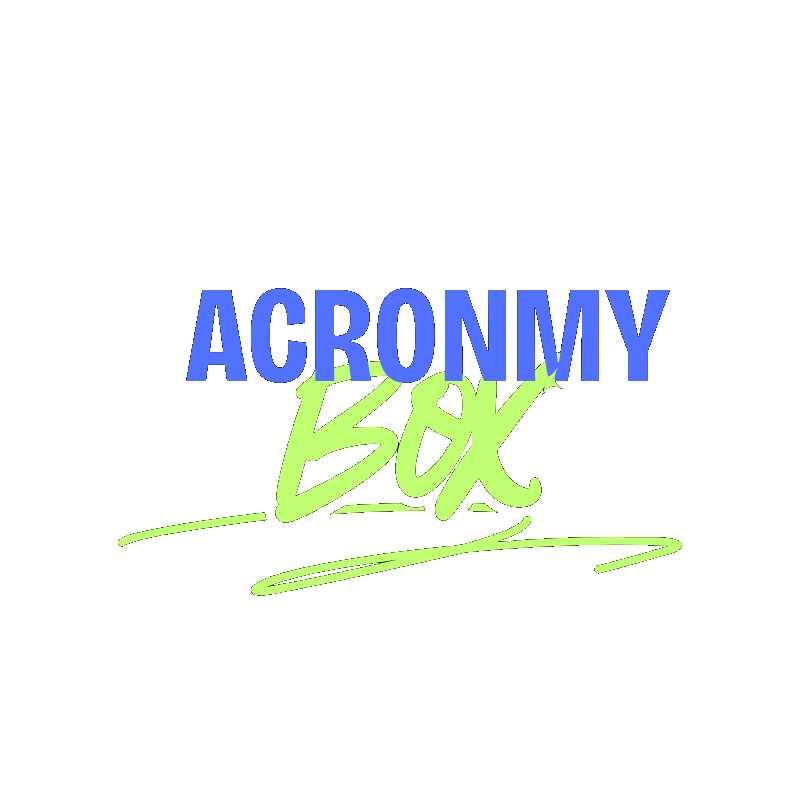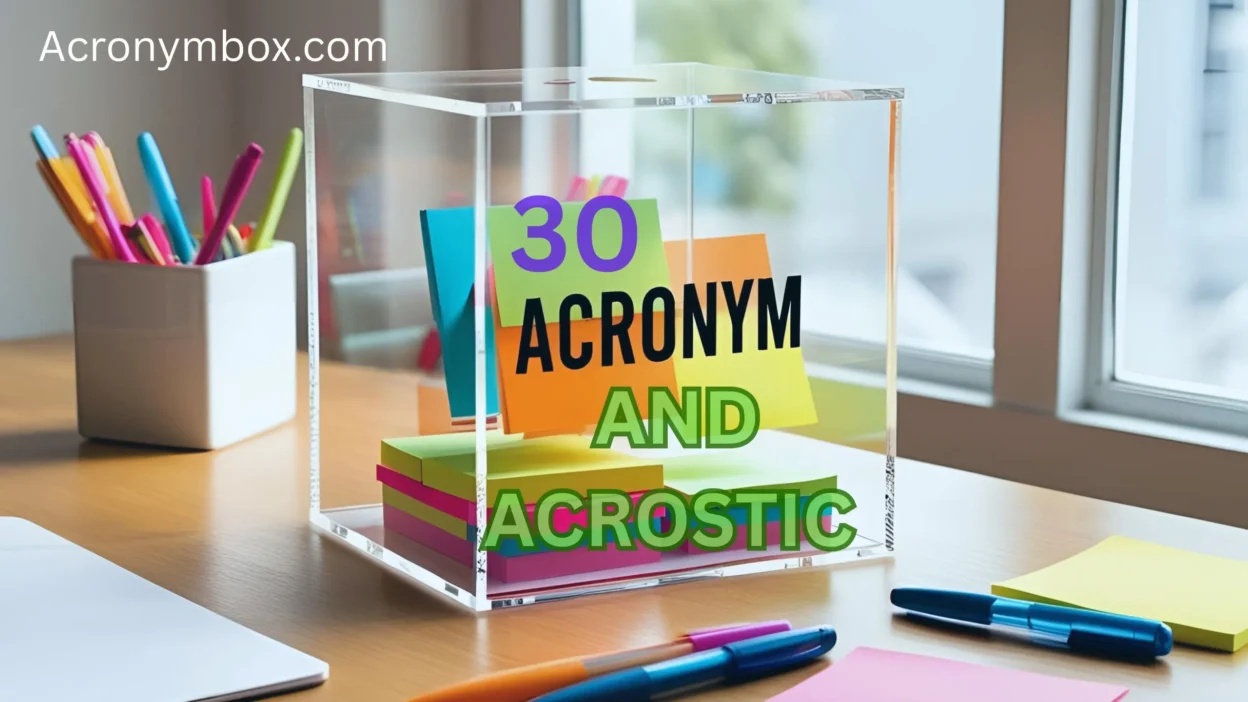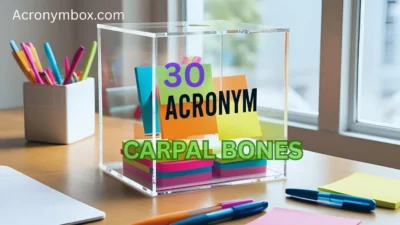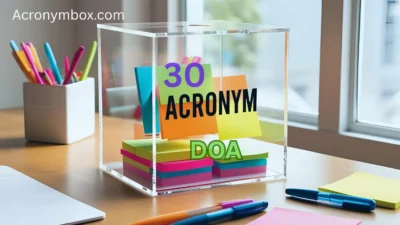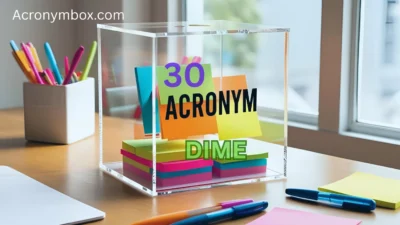When you’re diving into language creativity—especially in education, poetry, branding, or memory tricks—you’ll often hear the terms acrostic and acronym. They might seem interchangeable at first glance, but they serve distinct purposes and convey different types of communication style and memory aid.
This article explores the key differences between “acrostic” and “acronym,” and introduces 30 creative and purposeful alternatives or variations. Each entry comes with a brief explanation, a real-world usage scenario, and a clear sentence example.
🧩 What’s the Difference Between Acrostic and Acronym?
🔠 Acronym
An acronym is a word formed from the initial letters of a phrase, where those letters create a new, pronounceable word.
Example: NASA = National Aeronautics and Space Administration
📝 Acrostic
An acrostic is a type of poetic or mnemonic composition where the first letter of each line or phrase spells out a word when read vertically.
Example (for HOPE):
Holding on
Overcoming fear
Pushing forward
Every day
🧠 When to Use Which?
| Use Case | Acronym | Acrostic |
| Memorization | ✅ Great for fast recall | ✅ Great for layered ideas |
| Branding | ✅ Short & snappy | ❌ Less common |
| Poetry | ❌ Not used | ✅ Often used |
| Education | ✅ Easy to teach processes | ✅ Engaging for students |
| Creativity | ⚠️ Limited structure | ✅ Rich expression |
💡 30 Creative Alternatives and Variations (with Usage Tips)
Let’s look at 30 clever formats and variations that reflect or extend the use of acrostics and acronyms, each with clear context and tone guidance.
1. Backronym
An acronym formed after the word exists.
Use when reverse-engineering meaning.
“FAIL can be a backronym for First Attempt In Learning.”
2. Mnemonic Phrase
A full sentence to aid memory.
Use for educational tips.
“My Very Educated Mother Just Served Us Noodles” (planets).
3. Acro-Poem
A poetic form of acrostic.
Use for creative writing or school projects.
“LOVE: Listening, Offering, Valuing, Embracing.”
4. Word Ladder Acrostic
Each line forms a building idea, spelling the main word.
Use for motivational messages.
“RISE: Reach, Inspire, Strive, Elevate.”
5. Alphabet Poem
Each line starts with successive letters of the alphabet.
Use in classroom or artistic writing.
“A is for… B is for…”
6. Name Acronym
Using a person’s name to describe traits.
Use in character bios or gifts.
“JANE: Joyful, Artistic, Noble, Energetic.”
7. Compound Acronym
Combines acronyms into one larger system.
Use for technical or organizational systems.
“S.M.A.R.T. within P.L.A.N.”
8. Nested Acronym
An acronym inside another.
Use for complex ideas.
“H.O.P.E. – Helping Others (P.E.): Persist Every day.”
9. Visual Acrostic
Design layout where the vertical word is bolded or colored.
Use in posters, journals.
“GRIT” running down the side of a poem.
10. Syllabic Acronym
Uses syllables, not just letters.
Use for branding or catchy titles.
“Interpol” = International + Police.
🔤 More Unique Variations
11. Single-letter Mnemonics
Every letter stands alone as a trigger.
“B.L.T.” = Bread, Lettuce, Tomato.
12. Conceptual Acronym
Abstract ideas built into each letter.
“TIME: Trust, Intention, Mindfulness, Energy.”
13. Action Acronym
Each word is a verb or action.
“DASH: Do, Act, Solve, Help.”
14. Circular Acrostic
First and last letters spell the concept.
“Y.O.U.N.G. ends with ‘G’ but circles back to ‘Y’ for repetition.”
15. Educational Framework Acronym
Used in teaching, e.g., “RAISE” = Read, Answer, Interpret, Summarize, Evaluate.
16. Emotional Acrostic
Expresses feelings through structure.
“FEAR: False Evidence Appearing Real.”
17. Process Acronym
Breaks a process into steps.
“SIPDE” in driving: Scan, Identify, Predict, Decide, Execute.
18. Brand-First Acronym
Name first, then acronym meaning later.
“ROAR” for a leadership program: Reach, Organize, Act, Reflect.
19. Vertical Word Art
Word as visual poetry.
Use in posters, books.
Each letter in “PEACE” with illustrations.
20. Story Acrostic
Each letter becomes a story prompt.
“D.R.E.A.M.”: Daring Robot Escapes And Migrates.
🎨 Bonus Styles for Creativity
21. Alliteration Acrostic
All words begin with same sound or letter.
“Brave, Bold, Bright, Beautiful.”
22. Inverted Acrostic
Main word spelled from last to first.
“DEEP” as: Powerful, Empathic, Expressive, Dynamic (backward).
23. Two-Word Acronyms
Two letters per idea.
“BI-PO” = Big Picture, Optimism.
24. Numeric Acrostic
Each line starts with a number.
“1 – One chance, 2 – Two paths…”
25. Time-Acronym
Links words to time phrases.
“NOW = Navigate, Own, Win.”
26. Emotion-Led Mnemonic
Words tied to moods.
“CALM: Centered, Aware, Loving, Mindful.”
27. Metaphorical Acronym
Imagery-inspired.
“W.A.V.E. = Water, Adapt, Venture, Expand.”
28. Interactive Acrostic
Used in quizzes or fill-in activities.
Great for students: “What does each letter in STORM mean?”
29. Foreign Language Acrostic
One language vertically, another in translations.
“PAZ” (Spanish for peace): Patience, Acceptance, Zeal (in English).
30. Aesthetic Acronym
Built purely for sound and rhythm.
“ZEST: Zoom, Energize, Smile, Thrive.”
🎯 How to Choose the Right Form?
Here’s how to decide whether to use acrostic, acronym, or one of the 30 creative variations:
| Situation | Choose This |
| Memory Aid | Acronym or Mnemonic Phrase |
| Emotional Writing | Acrostic, Emotional Acronym |
| Teaching Tool | Process Acronym, Interactive Acrostic |
| Creative Writing | Acro-poem, Word Ladder, Alphabet Poem |
| Branding | Backronym, Conceptual Acronym |
Also consider:
- Tone: Use acrostics for poetic and emotional messages; acronyms for sharp, direct memory tools.
- Audience: Younger audiences love interactive formats; professionals might prefer process acronyms.
- Cultural Sensitivity: Avoid acronyms with unintended double meanings across cultures or languages.
✅ Conclusion
Whether you’re a teacher, writer, marketer, or student, knowing when and how to use acrostics and acronyms opens up new levels of communication. These word forms make complex ideas memorable, engaging, and emotionally resonant.
From classic mnemonics to poetic acrostics, and from brand slogans to creative prompts—you now have 30+ tools to make your words work smarter, not harder.
So go ahead—create, spell, and inspire. Your message will stick with people long after the letters fade.
